Mechanical Behaviors and Structure Safety of a Tunnel Crossing a Water-Rich Fault Fracture Zone—A Case Study
Abstract
:1. Introduction
2. Project Description
2.1. Engineering Overview
2.2. Excavation Method
3. Field Monitoring of Tunnel in Water-Abundant Fault Zone
3.1. Field Monitoring Program
3.2. Analysis of In Situ Monitoring Results
3.2.1. Vertical Displacement
3.2.2. Soil Pressure
3.2.3. Hydrostatic Pressure
3.2.4. Internal Force Characteristics of the Lining
3.3. Safety Factor
4. Numerical Analyses of Mechanical Behaviors of Tunnel Crossing Water-Abundant Fault Area
4.1. Establishment of Numerical Simulation Model
4.2. Principle of Fluid–Solid Coupling Calculation
4.2.1. Penetration Law
4.2.2. Effective Stress Principle
4.3. Parameters of Numerical Model
4.4. Layout of Monitoring Points in Numerical Simulation
4.5. Results and Analysis
4.5.1. Characterization of Vertical Displacement Changes
4.5.2. Characterization of Soil Pressure Changes
4.5.3. Characterization of Water Pressure Changes
4.5.4. Characterization of Structure Stress Changes of Secondary Lining
5. Conclusions
- (1)
- When the upper and lower two-step methods are used to excavate the tunnel in the water-rich fracture zone, the displacement and deformation of the initial support mainly go through two stages: the rapid change stage and the slow change stage. The deformation mainly occurs before and after crossing the fault fracture zone. At this stage, the displacement change is the most severe, and the displacement change rate of the vault reaches 2.8 mm/d.
- (2)
- The field results show that the water pressure, soil pressure, and secondary lining structure of the surrounding rock of the tunnel have undergone rapid changes and stable stages. The maximum earth pressure of the tunnel surrounding the rock in sections I and II are 2.3 MPa and 11.8 MPa, respectively, and the growth rate of earth pressure decreases from the vault to the arch bottom. The maximum water pressure is 1.15 MPa at the bottom of the tunnel in section II.
- (3)
- Compared with the monitoring results of the internal force of the tunnel support structure, in the process of crossing the V-level surrounding rock to the fault fracture zone, the bending moment of the lining increases the most at the left arch waist and the smallest at the right arch foot, which increases by 222.78% and 60.87% respectively. The axial force of the right spandrel increases the most, and the left spandrel increases the least, increasing by 2579.2% and 221.18%, respectively.
- (4)
- The numerical simulation results show that the displacement deformation of the primary support of the tunnel, the soil pressure of the surrounding rock, the water pressure, and the stress law of the secondary lining structure are consistent with the field monitoring results. The minimum safety factor of section I is at the left arch waist, with a value of 26.76. The minimum safety factor in section II is at the right arch shoulder, with a value of 2.57, but it is greater than the safety threshold of 2.4, and the structure is relatively safe.
Author Contributions
Funding
Data Availability Statement
Conflicts of Interest
References
- Yu, Z.; Xue, G.; Zhou, C. Application of complex signal analysis to process ground penetrating radar data. Chin. J. Rock Mech. Eng. 2005, 24, 798–802. [Google Scholar]
- Li, L.; Li, S.; Cui, J. Experimental research on chemical grout for treating water inrush in rock mass. Chin. J. Rock Mech. Eng. 2009, 30, 3642–3648. [Google Scholar]
- Li, S.; Xue, Y.; Zhang, Q.; Li, S.; Li, L.; Sun, K.; Ge, Y.; Su, M.; Zhong, S.; Li, X. Key technology study on comprehensive prediction and early-warning of geological hazards during tunnel construction in high-risk karst areas. Chin. J. Rock Mech. Eng. 2008, 27, 1297–1307. [Google Scholar]
- Zhang, Q.; Xu, Z.; Li, S. Integrated advanced geological prediction methods and engineering application of karst tunnels. J. Shandong Univ. 2009, 39, 7–11. [Google Scholar]
- Chen, W.; Mang, G.; Dai, Y. Stability analysis of diversion tunnel for Jinping hydro-power station. Chin. J. Geotech. Eng. 2008, 30, 1184–1190. [Google Scholar]
- Li, L. Study on Catastrophe Evolution Mechanism of Karst Water Inrush and it Engineering Application of High-Risk Karst Tunnel. Master’s Thesis, Shandong University, Jinan, Shandong, 2011. [Google Scholar]
- Li, L.; Zhou, Z.; Li, S.; Xue, Y.; Xu, Z.; Shi, S. An attribute synthetic evaluation system for risk assessment of floor water inrush in coal mines. Mine Water Environ. 2015, 34, 288. [Google Scholar] [CrossRef]
- Bai, J.; Duan, S.; Liu, R.; Xin, L.; Tian, J.; Zhang, Q.; Ma, H. Evolution of delayed water inrush in fault fracture zone considering time effect. Arab. J. Geosci. 2021, 14, 1001. [Google Scholar] [CrossRef]
- Wu, Y.; Zhuang, G.; Liang, W.; Huang, L. Safety analysis of secondary lining of Yulinzi Tunnel based on field monitoring. Appl. Sci. 2023, 13, 8328. [Google Scholar] [CrossRef]
- Huang, R.; Huang, J.; Ju, N.; Li, Y. Automated tunnel rock classification using rock engineering systems. Eng. Geol. 2013, 156, 20–27. [Google Scholar] [CrossRef]
- Wang, Y.; Chen, F.; Sui, W.; Meng, F.; Geng, F. Large-scale model test for studying the water inrush during tunnel excavation in fault. Bull. Eng. Geol. Environ. 2022, 81, 238. [Google Scholar] [CrossRef]
- Huang, C.; Zhang, S.; Wu, S.; Gao, Y. Research and application of a comprehensive forecasting system for tunnels in water-bearing fault fracture zones: A case study. Arab. J. Geosci. 2022, 15, 171. [Google Scholar] [CrossRef]
- Liu, J.; Li, Z.; Zhang, X.; Weng, X. Analysis of Water and Mud Inrush in Tunnel Fault Fracture Zone—A Case Study of Yonglian Tunnel. Sustainability 2021, 13, 9585. [Google Scholar] [CrossRef]
- Zhang, J.; Li, S.; Zhang, Q.; Zhang, X.; Li, P.; Wang, D.; Weng, X. Mud inrush flow mechanisms: A case study in a water-rich fault tunnel. Bull. Eng. Geol. Environ. 2019, 78, 6267–6283. [Google Scholar] [CrossRef]
- Zhong, Z.; Li, Y.; Zhou, X. Research on the Safety Thickness of Tunnel Outburst Prevention in Water-Rich Fault Fracture Zone Based on Janssen’s Theory. Geofluids 2022, 2022, 6247439. [Google Scholar] [CrossRef]
- Guo, Y.; Kong, Z.; He, J.; Yan, M. Development and application of the 3D model test system for water and mud inrush of water-rich fault fracture zone in deep tunnels. Math. Probl. Eng. 2021, 2021, 8549094. [Google Scholar] [CrossRef]
- Lyu, G.; Zhou, C.; Jiang, N. Experimental and numerical study on tunnel blasting induced damage characteristics of grouted surrounding rock in fault zones. Rock Mech. Rock Eng. 2023, 56, 603–617. [Google Scholar] [CrossRef]
- Wang, H.; Chen, Z.; Liu, S.; Liang, M. Study on Technology of Surface Pre-grouting for Vertical Shaft in Broken and Water-rich Granite Strata of Gaoligong Mountain Tunnel of Dali-Ruili Railway. In IOP Conference Series: Earth and Environmental Science. IOP Publ. 2019, 218, 012125. [Google Scholar]
- Fan, H.; Li, L.; Chen, G.; Liu, H.; Gao, J.; Li, C.; Peng, X.; Zhou, S. Analysis method of the water inrush and collapse in jointed rock mass tunnels: A case study. Eng. Anal. Bound. Elem. 2023, 146, 838–850. [Google Scholar]
- Jeon, S.; Kim, J.; Seo, Y.; Hong, C. Effect of a fault and weak plane on the stability of a tunnel in rock—A scaled model test and numerical analysis. Int. J. Rock Mech. Min. Sci. 2004, 41, 658–663. [Google Scholar] [CrossRef]
- Kun, M.; Onargan, T. Influence of the fault zone in shallow tunneling: A case study of Izmir Metro Tunnel. Tunn. Undergr. Space Technol. 2013, 33, 34–45. [Google Scholar] [CrossRef]
- Su, H.; Jing, H.; Zhao, H.; Yu, L.; Wang, Y. Strength degradation and anchoring behavior of rock mass in the fault fracture zone. Environ. Earth Sci. 2017, 76, 179. [Google Scholar] [CrossRef]
- Zhang, Z.; Chen, F.; Li, N.; Swoboda, G.; Liu, N. Influence of fault on the surrounding rock stability of a tunnel: Location and thickness. Tunn. Undergr. Space Technol. 2017, 61, 1–11. [Google Scholar] [CrossRef]
- Huang, F.; Wu, C.; Ni, P.; Wan, G.; Zheng, A.; Jang, B.; Karekal, S. Experimental analysis of progressive failure behavior of rock tunnel with a fault zone using non-contact DIC technique. Int. J. Rock Mech. Min. Sci. 2020, 132, 104355. [Google Scholar] [CrossRef]
- Wang, X.; Zhang, Y.; Zhang, Q.; Wei, Y.; Liu, W.; Jiang, T. Space-time evolution characteristics of deformation and failure of surrounding rock in deep soft rock roadway. Sustainability 2022, 14, 12587. [Google Scholar] [CrossRef]
- Lei, Q.; Tsang, C. Numerical study of fluid injection-induced deformation and seismicity in a mature fault zone with a low-permeability fault core bounded by a densely fractured damage zone. Geomech. Energy Environ. 2022, 31, 100277. [Google Scholar] [CrossRef]
- Fang, W.; Wang, G.; Wang, C. Effect of the Location of Fault Fracture Zones on the Stability of Symmetrical Submarine Tunnels. Symmetry 2021, 13, 1111. [Google Scholar] [CrossRef]
- Li, X.; Xu, G.; Wu, C.; Wu, S.; Zu, A.; Chen, G.; Li, Z.; Xu, S.; Li, Y. Pure Void Space and Fracture Pore Space in Fault-Fractured Zones. Front. Earth Sci. 2021, 9, 683439. [Google Scholar] [CrossRef]
- Li, Z.; Mao, H.; Li, B.; Zhou, X.; Liao, G.; Chen, J. Stability Analysis and Fracture Mechanism of Surrounding Rock in a Hydraulic Tunnel Based on Micro seismic Monitoring. Appl. Sci. 2022, 12, 9362. [Google Scholar] [CrossRef]
- Shrestha, P.; Panthi, K. Groundwater effect on faulted rock mass: An evaluation of Modi Khola pressure tunnel in the Nepal Himalaya. Rock Mech. Rock Eng. 2014, 47, 1021–1035. [Google Scholar] [CrossRef]
- Wu, J.; Wang, X.; Wu, L.; Lu, Y.; Han, Y. Parametric Study of Water Inrush in a Tunnel Crossing a Fault Based on the “Three Zones” Fault Structure. KSCE J. Civ. Eng. 2022, 26, 3600–3619. [Google Scholar] [CrossRef]
- Wang, P.; Xu, J.; Li, C. Similar simulation test study on permeability evolution mechanism of fault sliding fracture zone. Arab. J. Geosci. 2022, 15, 548. [Google Scholar] [CrossRef]
- Wei, S.; Li, Y.; Shang, Y.; Sun, Y.; Li, K. Stability analysis of fractured rock mass around underground excavations based on a three-dimensional discrete fracture network. Environ. Earth Sci. 2022, 81, 65. [Google Scholar] [CrossRef]
- Cheng, X.; Ding, W.; Pan, L.; Zou, Y.; Li, Y.; Yin, Y.; Ding, S. Geometry and kinematics characteristics of strike-slip fault zone in complex structure area: A case study from the South No. 15 strike-slip fault zone in the Eastern Sichuan Basin, China. Front. Earth Sci. 2022, 10, 922664. [Google Scholar] [CrossRef]
- Chen, Z.; Zhou, Z.; He, C.; Jiang, C.; Wang, B.; Li, T. Influence of faults on the geo-stress field distribution and damage evolution mechanism of fracture zones. Bull. Eng. Geol. Environ. 2023, 82, 173. [Google Scholar] [CrossRef]
- Liu, J.; Zhang, X.; Li, X.; Li, Z.; Sun, C. A New Quantitative Evaluation Index System for Disaster-Causing Factors of Mud Inrush Disasters in Water-Rich Fault Fracture Zone. Appl. Sci. 2023, 13, 6199. [Google Scholar] [CrossRef]
- Li, B.; Liu, Z.; Wu, Q.; Long, J.; Liu, P.; Li, M. Prediction Model for Safe Width of Rock Mass Preventing Water Inrush from Fault in Excavation Roadway and Influencing Factors Analysis: A Case Study of the Xintian Coal Mine. Min. Metall. Explor. 2023, 40, 1225–1235. [Google Scholar] [CrossRef]
- Sun, N.; Liu, C.; Zhang, F.; Dong, M.; Li, Z. Accurate Identification of Broken Rock Mass Structure and Its Application in Stability Analysis of Underground Caverns Surrounding Rock. Appl. Sci. 2023, 13, 6964. [Google Scholar] [CrossRef]
- JTG 3370.1-2018; Specifications for Design of Highway Tunnels: Section I Civil Engineering. China Communications Press: Beijing, China, 2019.
- Chen, B.; Zhang, Z.; Tan, Y. Study on structural mechanical characteristics and safety warning of NATM tunnel in aquifer. Marine. Georesources Geotechnol. 2024, 42, 88–103. [Google Scholar] [CrossRef]
- SIMULIA. Abaqus Analysis: User’s Manual; Dassault Systems: Vélizy-Villacoublay, France, 2012; Available online: https://www.academia.edu/24831145/Abaqus_Analysis_Users_Manual (accessed on 5 February 2024).
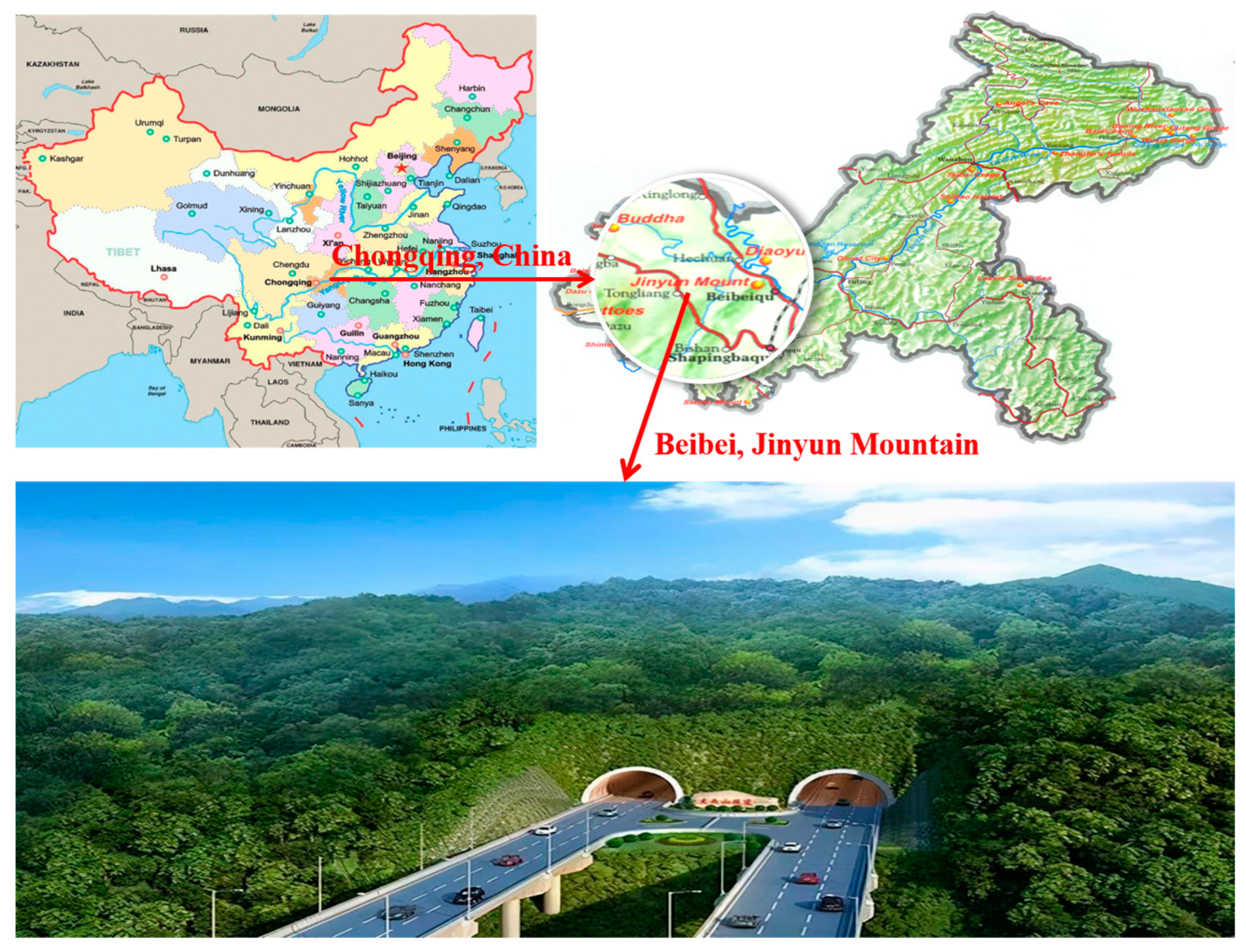
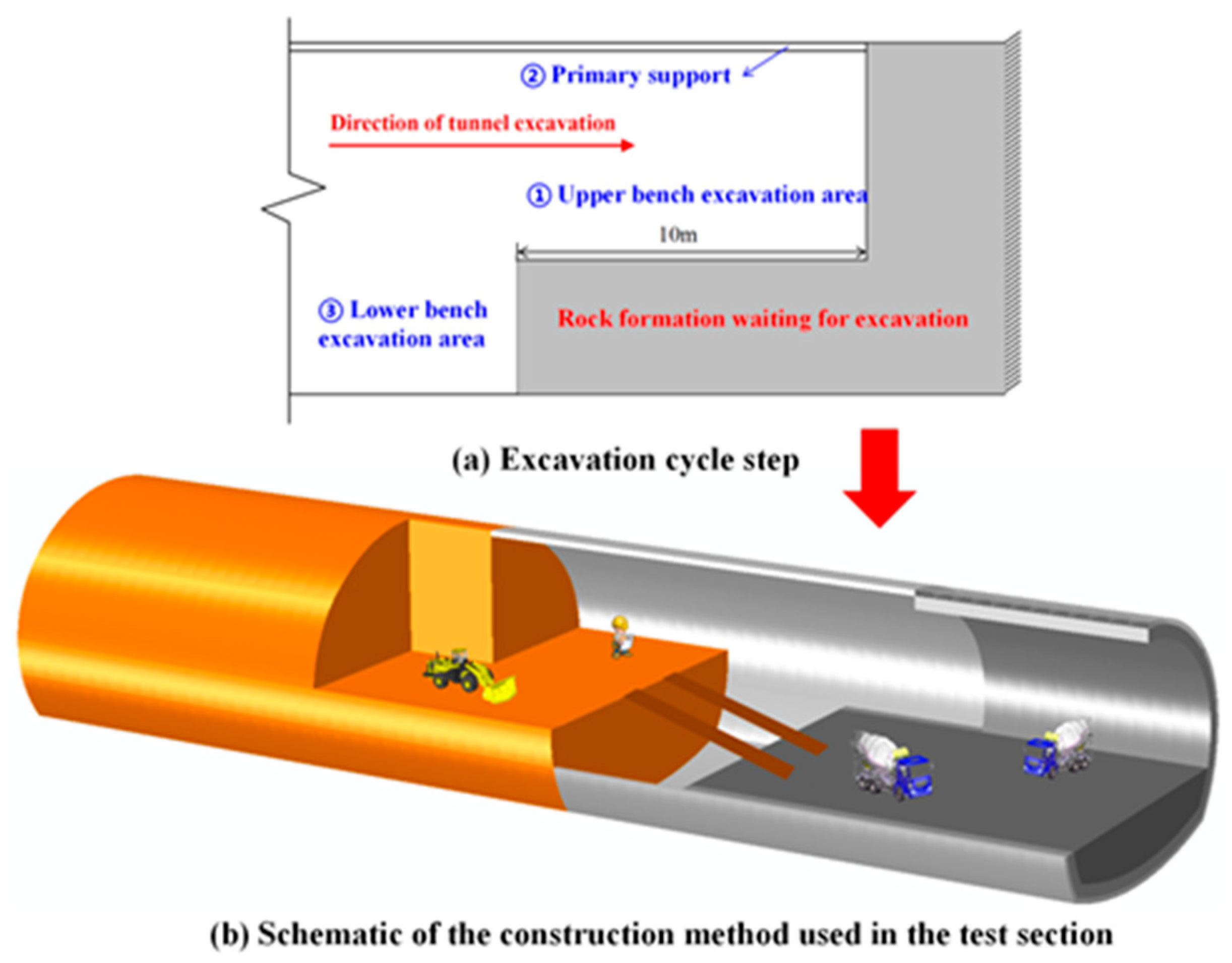

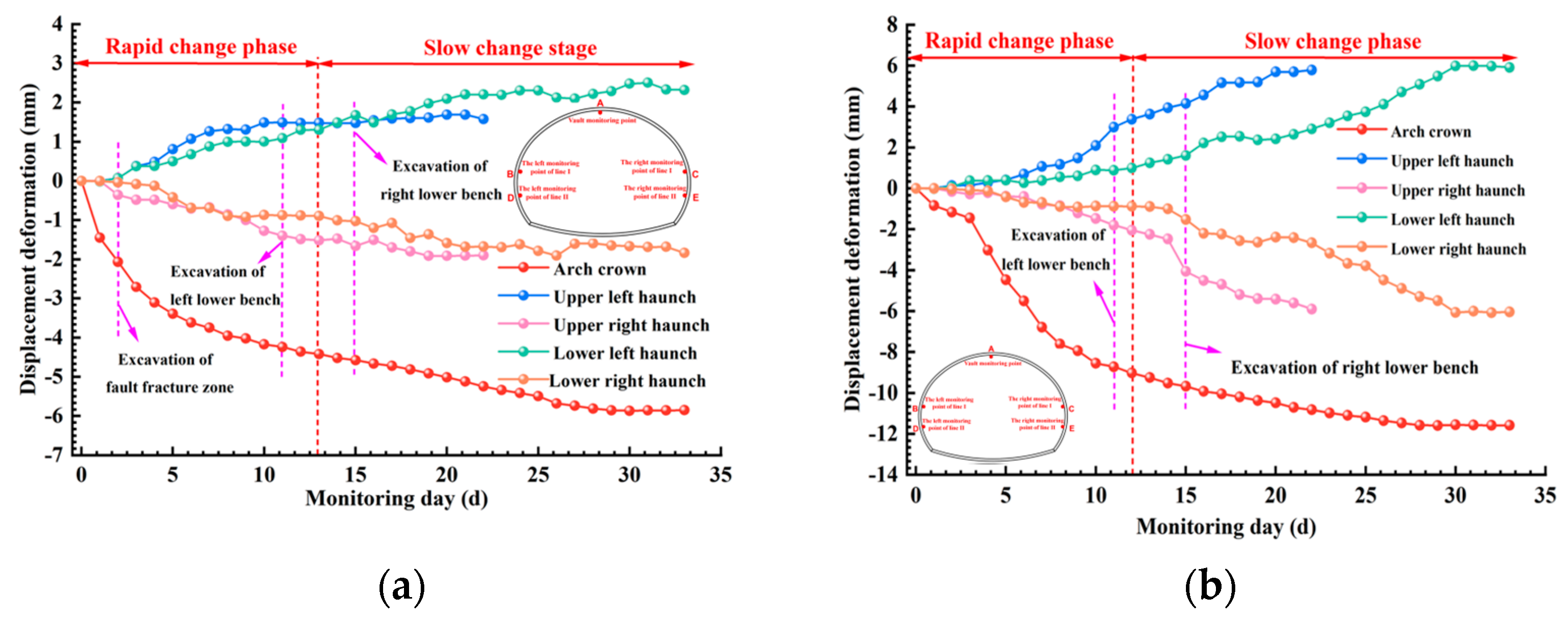




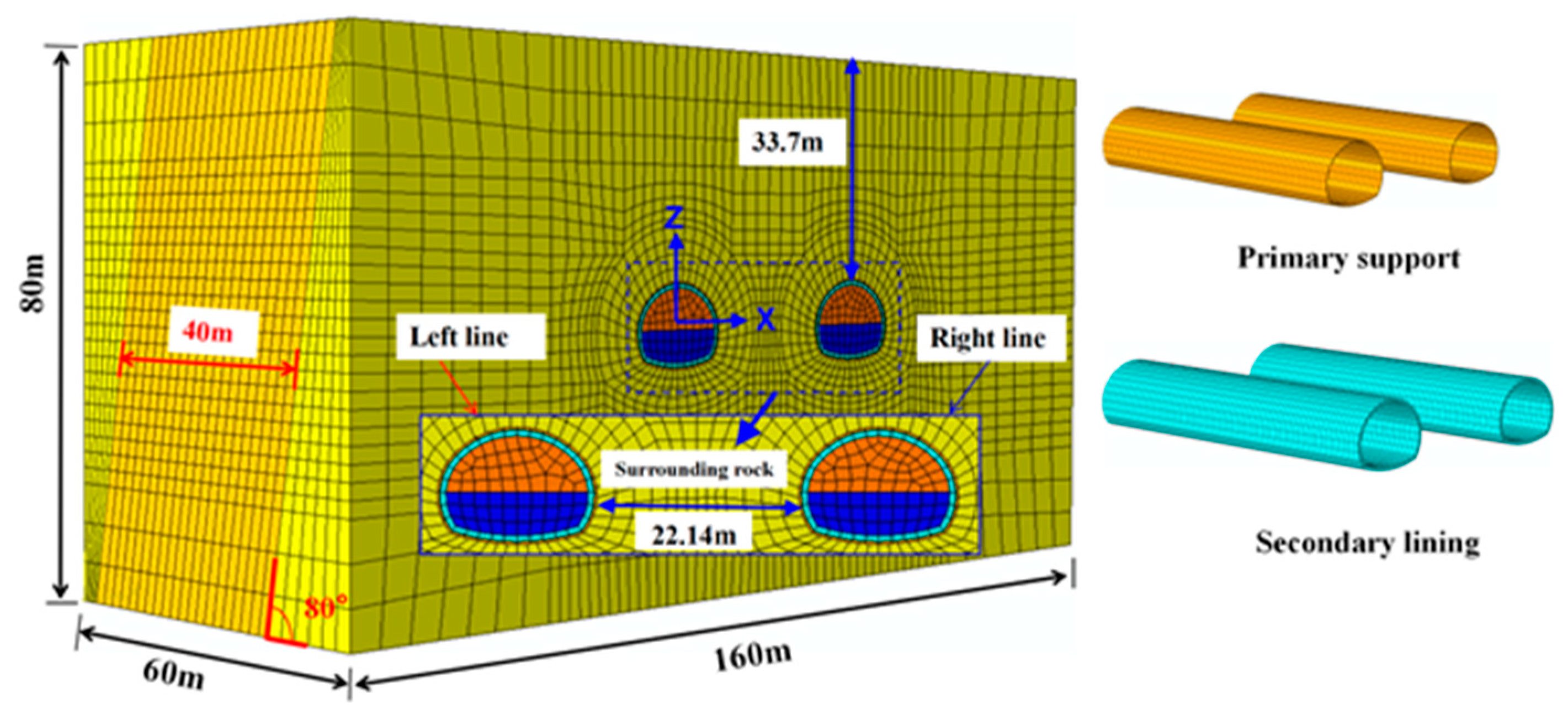


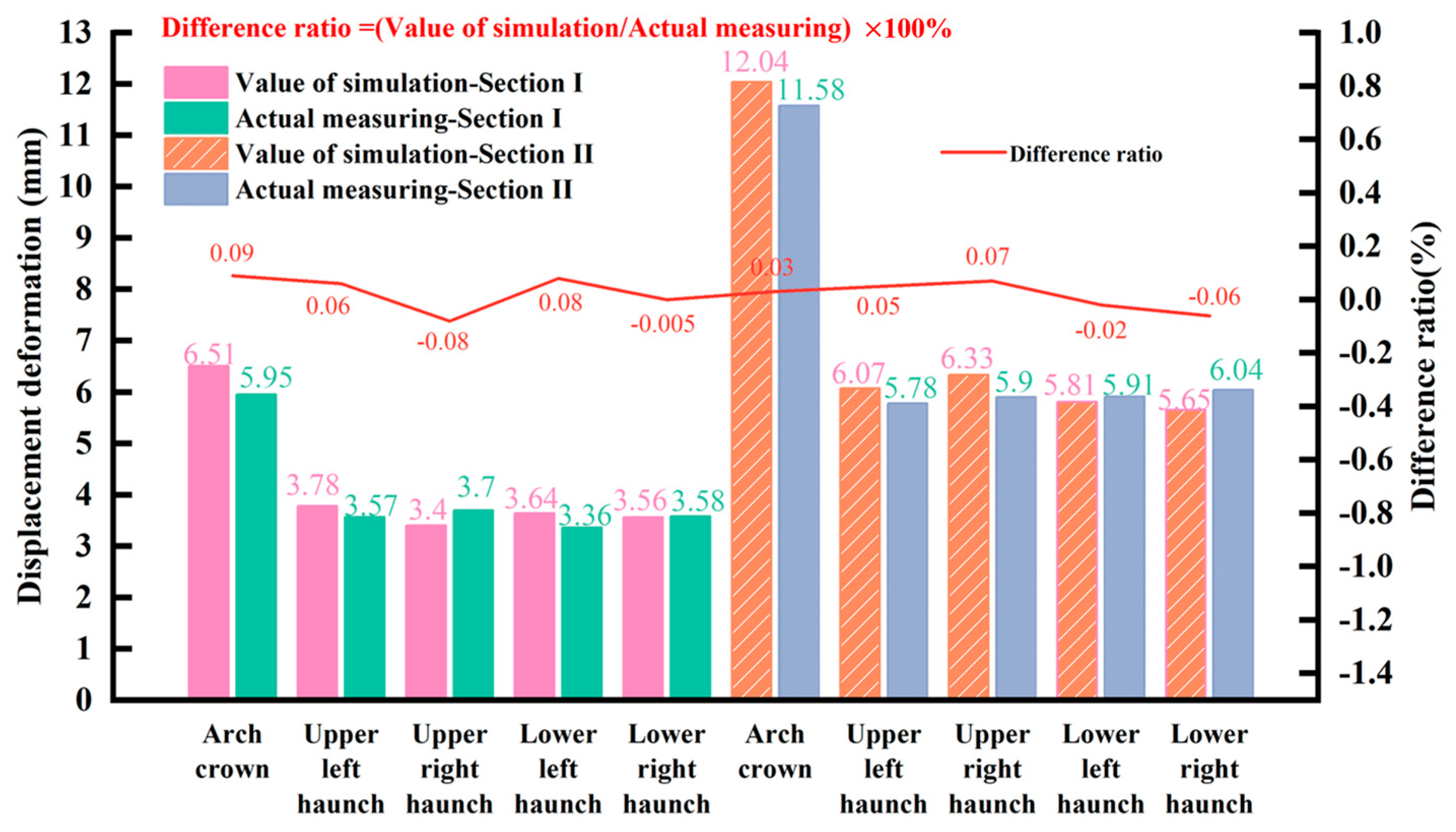
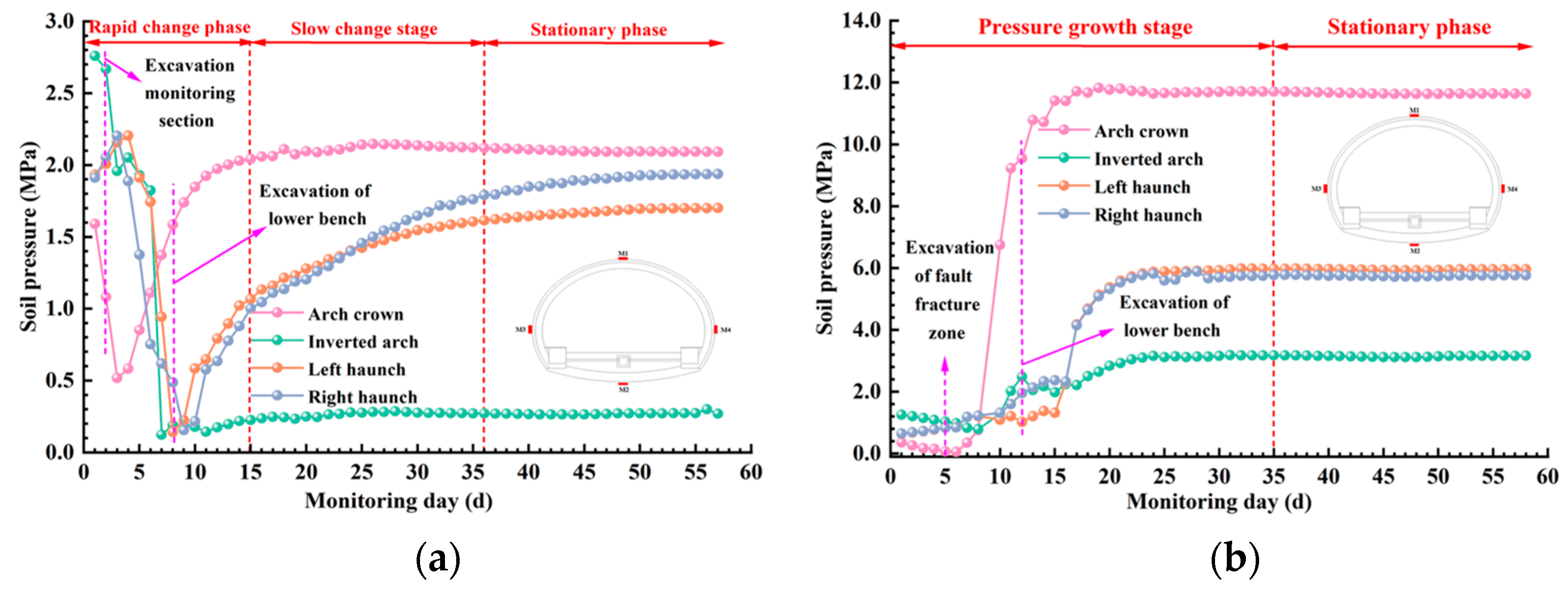

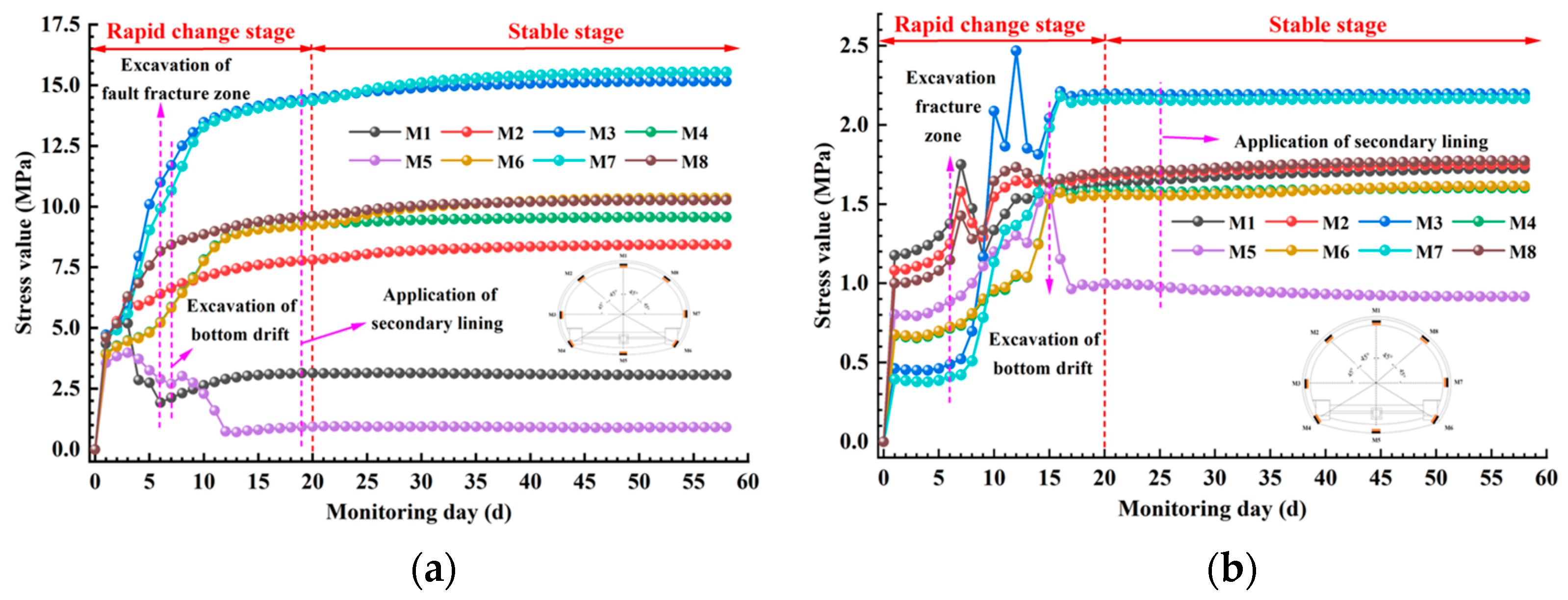

| Name | Density (kg/m3) | Elastic Modulus (GPa) | Poisson’s Ratio | Cohesion (MPa) | Angle of Internal Friction (°) | Permeability Coefficient (m/s) | Void Ratio |
|---|---|---|---|---|---|---|---|
| Grade-V Rock Mass | 2200 | 2.5 | 0.25 | 2.9 | 39 | 5 × 10−8 | 0.3 |
| Rock mass in Fault and Fracture Zone | 1700 | 1 | 0.32 | 0.7 | 22 | 2 × 10−6 | 0.5 |
| Primary Support | 2500 | 28.539 | 0.2 | 300 | 50 | 8 × 10−9 | 0.1 |
| Secondary Lining | 2800 | 33.625 | 0.18 | 1000 | 50 | 8 × 10−10 | 0.05 |
Disclaimer/Publisher’s Note: The statements, opinions and data contained in all publications are solely those of the individual author(s) and contributor(s) and not of MDPI and/or the editor(s). MDPI and/or the editor(s) disclaim responsibility for any injury to people or property resulting from any ideas, methods, instructions or products referred to in the content. |
© 2024 by the authors. Licensee MDPI, Basel, Switzerland. This article is an open access article distributed under the terms and conditions of the Creative Commons Attribution (CC BY) license (https://creativecommons.org/licenses/by/4.0/).
Share and Cite
Chen, L.; Deng, Y.; Yang, B.; Wang, S.; Li, H.; Tan, Y. Mechanical Behaviors and Structure Safety of a Tunnel Crossing a Water-Rich Fault Fracture Zone—A Case Study. Buildings 2024, 14, 475. https://doi.org/10.3390/buildings14020475
Chen L, Deng Y, Yang B, Wang S, Li H, Tan Y. Mechanical Behaviors and Structure Safety of a Tunnel Crossing a Water-Rich Fault Fracture Zone—A Case Study. Buildings. 2024; 14(2):475. https://doi.org/10.3390/buildings14020475
Chicago/Turabian StyleChen, Linjie, Yuan Deng, Biao Yang, Siqi Wang, Huayun Li, and Yinjun Tan. 2024. "Mechanical Behaviors and Structure Safety of a Tunnel Crossing a Water-Rich Fault Fracture Zone—A Case Study" Buildings 14, no. 2: 475. https://doi.org/10.3390/buildings14020475





